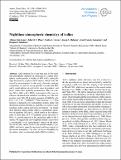Por favor, use este identificador para citar o enlazar a este item:
http://hdl.handle.net/10261/158737COMPARTIR / EXPORTAR:
 SHARE SHARE
 CORE
BASE CORE
BASE
|
|
| Visualizar otros formatos: MARC | Dublin Core | RDF | ORE | MODS | METS | DIDL | DATACITE | |

| Campo DC | Valor | Lengua/Idioma |
|---|---|---|
| dc.contributor.author | Saiz-Lopez, A. | - |
| dc.contributor.author | Plane, John M.C. | - |
| dc.contributor.author | Cuevas, Carlos A. | - |
| dc.contributor.author | Mahajan, Anoop S. | - |
| dc.contributor.author | Lamarque, Jean-François | - |
| dc.contributor.author | Kinnison, Douglas E. | - |
| dc.date.accessioned | 2018-01-02T12:45:58Z | - |
| dc.date.available | 2018-01-02T12:45:58Z | - |
| dc.date.issued | 2016 | - |
| dc.identifier | doi: 10.5194/acp-16-15593-2016 | - |
| dc.identifier | issn: 1680-7324 | - |
| dc.identifier.citation | Atmospheric Chemistry and Physics 16: 15593- 15604 (2016) | - |
| dc.identifier.uri | http://hdl.handle.net/10261/158737 | - |
| dc.description.abstract | Little attention has so far been paid to the nighttime atmospheric chemistry of iodine species. Current atmospheric models predict a buildup of HOI and I during the night that leads to a spike of IO at sunrise, which is not observed by measurements. In this work, electronic structure calculations are used to survey possible reactions that HOI and I could undergo at night in the lower troposphere, and hence reduce their nighttime accumulation. The new reaction NO+HOI→IO+HNO is proposed, with a rate coefficient calculated from statistical rate theory over the temperature range 260-300K and at a pressure of 1000 hPa to be k.T ) =2.7×10 (300 K/T) cm molecule s. This reaction is included in two atmospheric models, along with the known reaction between I and NO, to explore a new nocturnal iodine radical activation mechanism. The results show that this iodine scheme leads to a considerable reduction of nighttime HOI and I, which results in the enhancement of more than 25% of nighttime ocean emissions of HOI+I and the removal of the anomalous spike of IO at sunrise. We suggest that active nighttime iodine can also have a considerable, so far unrecognized, impact on the reduction of the NO radical levels in the marine boundary layer (MBL) and hence upon the nocturnal oxidizing capacity of the marine atmosphere. The effect of this is exemplified by the indirect effect on dimethyl sulfide (DMS) oxidation. | - |
| dc.publisher | European Geophysical Society | - |
| dc.relation.isversionof | Publisher's version | - |
| dc.rights | openAccess | - |
| dc.title | Nighttime atmospheric chemistry of iodine | - |
| dc.type | artículo | - |
| dc.identifier.doi | 10.5194/acp-16-15593-2016 | - |
| dc.date.updated | 2018-01-02T12:45:58Z | - |
| dc.description.version | Peer Reviewed | - |
| dc.language.rfc3066 | eng | - |
| dc.relation.csic | Sí | - |
| dc.type.coar | http://purl.org/coar/resource_type/c_6501 | es_ES |
| item.fulltext | With Fulltext | - |
| item.openairecristype | http://purl.org/coar/resource_type/c_18cf | - |
| item.cerifentitytype | Publications | - |
| item.grantfulltext | open | - |
| item.openairetype | artículo | - |
| Aparece en las colecciones: | (IQF) Artículos | |
Ficheros en este ítem:
| Fichero | Descripción | Tamaño | Formato | |
|---|---|---|---|---|
| AtChemPhys_2016_15593.pdf | 6,59 MB | Adobe PDF |  Visualizar/Abrir |
CORE Recommender
SCOPUSTM
Citations
28
checked on 18-abr-2024
WEB OF SCIENCETM
Citations
25
checked on 23-feb-2024
Page view(s)
292
checked on 23-abr-2024
Download(s)
287
checked on 23-abr-2024
Google ScholarTM
Check
Altmetric
Altmetric
NOTA: Los ítems de Digital.CSIC están protegidos por copyright, con todos los derechos reservados, a menos que se indique lo contrario.
